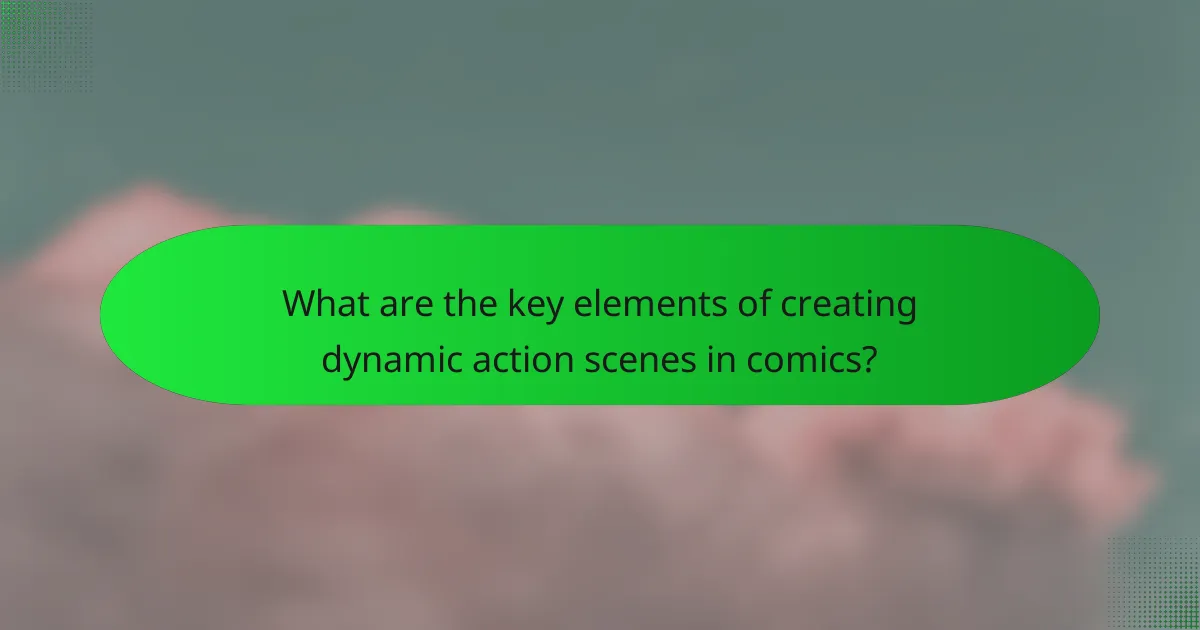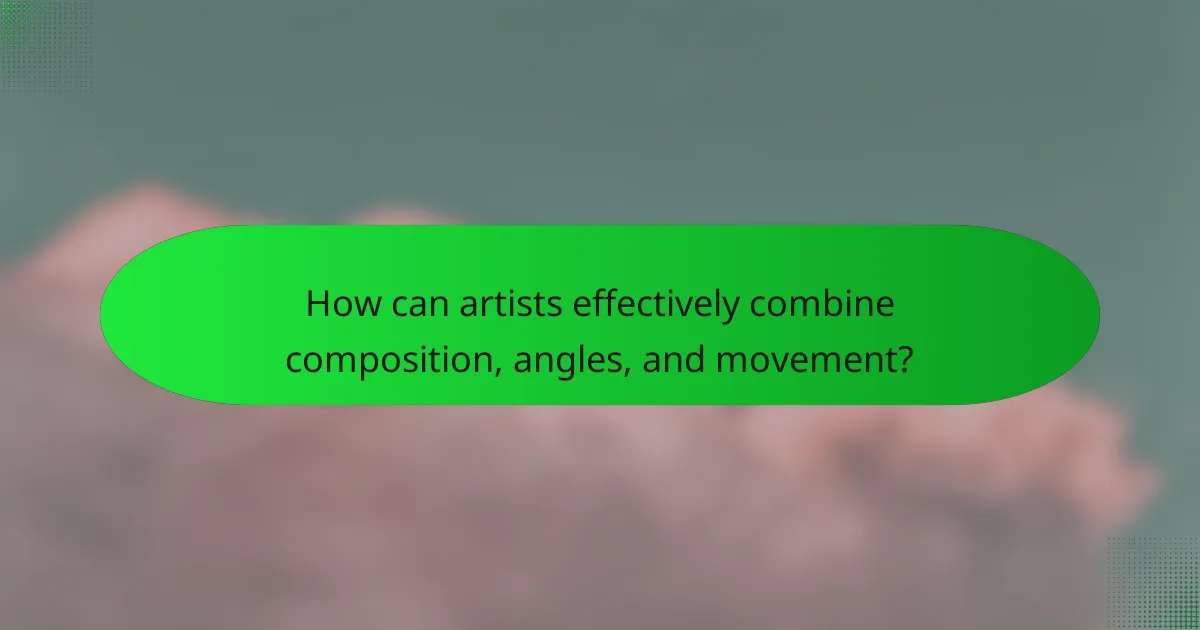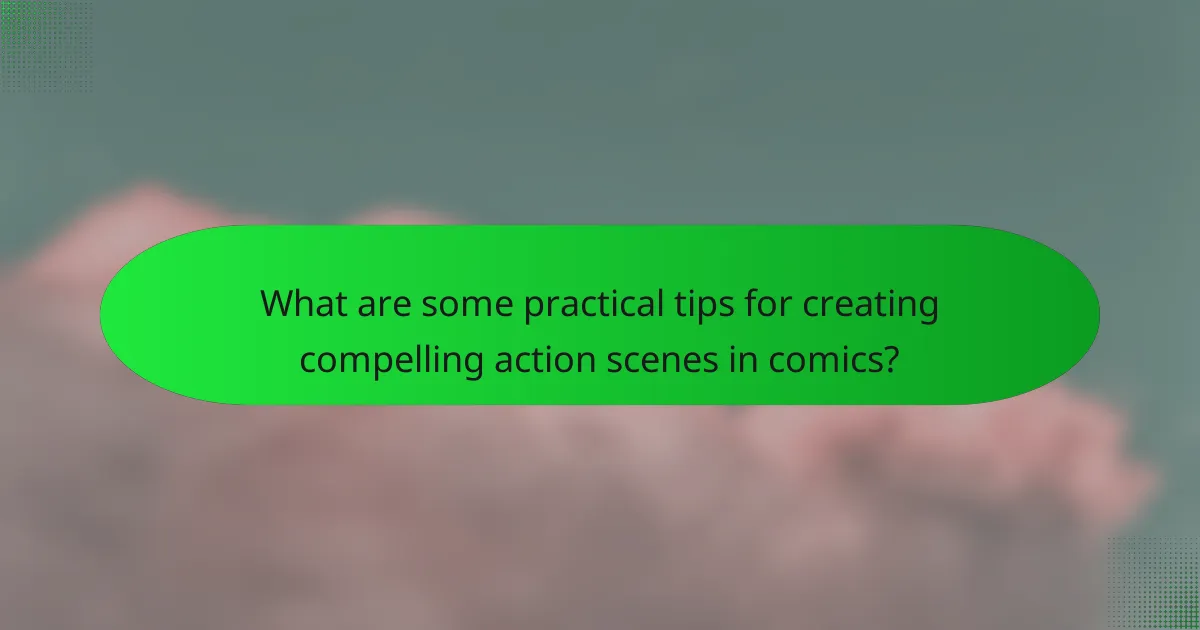Creating dynamic action scenes in comics involves key elements such as composition, angles, and movement. Composition refers to the arrangement of visual elements that guide the reader’s eye and enhance storytelling. Angles, including low and high perspectives, can evoke emotions and add depth, while movement is depicted through dynamic poses and action lines to convey speed and intensity. Effective panel layouts influence pacing and impact, allowing artists to create engaging scenes that resonate with readers. Techniques like the rule of thirds, varying panel sizes, and contrasting colors further enhance the visual narrative, ensuring a compelling experience for the audience.

What are the key elements of creating dynamic action scenes in comics?
The key elements of creating dynamic action scenes in comics include composition, angles, and movement. Composition involves arranging visual elements to guide the reader’s eye and enhance storytelling. Effective angles can create a sense of depth and excitement. Low or high perspectives can emphasize action or character emotions. Movement should be depicted through dynamic poses and lines to convey speed and intensity. Additionally, the use of panel layout can influence pacing and impact. These elements work together to engage readers and create an immersive experience.
How does composition influence the effectiveness of action scenes?
Composition significantly influences the effectiveness of action scenes by guiding the viewer’s focus and enhancing emotional impact. A well-structured composition can create a sense of movement and urgency. For instance, diagonal lines in a panel can suggest speed and dynamism. The placement of characters within the frame can emphasize conflict and tension. Additionally, the use of negative space can heighten drama by isolating characters. Research shows that visual hierarchy directs attention and impacts storytelling. Effective compositions often lead to more engaging and memorable action sequences.
What are the fundamental principles of composition in comic art?
The fundamental principles of composition in comic art include balance, contrast, emphasis, movement, and unity. Balance ensures visual stability in a panel, distributing elements evenly. Contrast highlights differences in color, size, or shape to draw attention. Emphasis directs the viewer’s focus to key elements, often through size or placement. Movement guides the reader’s eye across the page, creating a sense of action. Unity ensures all elements work together cohesively, creating a harmonious overall effect. These principles are essential for effective storytelling and visual engagement in comics.
How do visual balance and focal points enhance action scenes?
Visual balance and focal points enhance action scenes by guiding the viewer’s attention and creating a sense of harmony. Visual balance ensures that elements within the scene are arranged in a way that feels stable and engaging. This stability allows viewers to focus on key moments without feeling overwhelmed. Focal points draw attention to the most important aspects of the action, such as characters or pivotal movements.
For example, in comic panels, a character in motion can be highlighted through contrasting colors or placement. This technique directs the viewer’s gaze and emphasizes the action. Studies in visual perception show that balanced compositions improve clarity and understanding of dynamic scenes. Research indicates that focal points increase emotional impact by connecting viewers to the narrative. Overall, effective use of visual balance and focal points enhances the storytelling experience in action scenes.
What role do angles play in depicting movement and action?
Angles significantly influence the depiction of movement and action in visual storytelling. They help convey the dynamics of a scene. For instance, low angles can make characters appear powerful and imposing. High angles can create a sense of vulnerability or defeat. The choice of angle affects the viewer’s perception of speed and direction. Angles can also emphasize the intensity of action by creating a sense of depth. Dynamic angles, such as Dutch tilts, can evoke tension and chaos. Studies in visual perception indicate that angles impact emotional responses to action scenes. Thus, angles serve as vital tools in illustrating movement and enhancing narrative engagement.
How can different camera angles alter the perception of a scene?
Different camera angles significantly alter the perception of a scene. High angles make subjects appear smaller and more vulnerable. Low angles can convey power and dominance, making subjects seem larger than life. Eye-level angles provide a neutral perspective, fostering a sense of realism. Dutch angles create tension and unease, often used in dramatic moments. Wide shots establish context and scale, highlighting the environment around the subject. Close-ups focus on details, enhancing emotional engagement. Each angle influences viewer interpretation and emotional response, shaping the narrative effectively. Studies in film and photography confirm these effects, demonstrating how angles impact storytelling.
What are the most effective angles for conveying intensity and drama?
Effective angles for conveying intensity and drama include low angles, high angles, and extreme close-ups. Low angles create a sense of power and dominance. High angles can evoke vulnerability or weakness. Extreme close-ups focus on [censured] expressions, heightening emotional impact. These angles manipulate viewer perception and engagement with the scene. For instance, films like “The Dark Knight” use low angles to emphasize the Joker’s menacing presence. Research indicates that angle choice significantly influences audience emotional response.
How does movement contribute to the dynamism of action scenes?
Movement enhances the dynamism of action scenes by creating a sense of energy and urgency. It captures the viewer’s attention and conveys the intensity of the moment. Dynamic movement can include fast-paced actions like running, jumping, or fighting. These actions generate visual excitement and keep the audience engaged. The use of varying angles and perspectives can amplify the impact of movement. For instance, low angles can make characters appear more powerful during action sequences. Additionally, fluid motion can create a rhythm that draws readers into the narrative. Studies in visual storytelling show that movement is essential for conveying emotion and tension. Therefore, effective use of movement is crucial for dynamic action scenes in comics.
What techniques can artists use to illustrate motion in comics?
Artists can use techniques such as motion lines, blurring, and dynamic poses to illustrate motion in comics. Motion lines visually indicate the direction and speed of movement. They create a sense of action by extending from the moving object. Blurring effects can be applied to emphasize rapid motion. This technique simulates the way objects appear when they move quickly. Dynamic poses involve exaggerated angles and positions to convey energy and movement. Artists often use foreshortening to create depth and perspective. These techniques collectively enhance the visual narrative of action scenes in comics.
How can pacing and timing affect the flow of action sequences?
Pacing and timing are crucial for the flow of action sequences. They determine how quickly events unfold and how tension builds. Effective pacing creates a rhythm that keeps the audience engaged. For instance, short panels can accelerate action, while longer panels allow for dramatic pauses. Timing influences the emotional impact of each moment. It can heighten suspense or provide relief. Studies show that varying pacing enhances reader experience. For example, a rapid sequence can evoke excitement, while a slow one can build anticipation. Thus, pacing and timing shape the overall narrative experience in action sequences.

How can artists effectively combine composition, angles, and movement?
Artists can effectively combine composition, angles, and movement by strategically planning their layouts. Composition involves arranging elements to create a cohesive visual narrative. Angles influence the perspective and can evoke different emotions. Movement can be depicted through dynamic poses and action lines.
Using the rule of thirds can enhance composition by guiding the viewer’s eye. Varying angles, such as low or high perspectives, can add drama. Incorporating diagonal lines can suggest movement and energy in the scene.
For instance, in action comics, a low angle can make characters appear more powerful. Meanwhile, a bird’s-eye view can show the scale of a battle. Artists often use motion lines to indicate speed and direction. This technique helps convey a sense of action effectively.
Thus, by thoughtfully integrating composition, angles, and movement, artists can create engaging and dynamic scenes that resonate with readers.
What strategies can be employed to integrate these elements seamlessly?
To integrate composition, angles, and movement seamlessly in dynamic action scenes in comics, use contrasting elements strategically. Varying the composition creates visual interest and directs the reader’s attention. Employing different angles enhances the sense of depth and perspective. Movement can be illustrated through dynamic poses and motion lines.
For example, placing characters in off-center positions can create tension. Utilizing low or high angles can make characters appear more powerful or vulnerable. Incorporating overlapping elements can suggest motion and continuity. The use of color and shading can further enhance these effects, guiding the viewer’s eye through the scene.
Research shows that effective composition leads to better storytelling in visual media. Studies indicate that readers are more engaged when action scenes utilize varied perspectives and dynamic layouts. These strategies not only enhance visual appeal but also improve narrative clarity.
How can thumbnails and storyboards aid in planning action scenes?
Thumbnails and storyboards aid in planning action scenes by providing a visual representation of sequences. They help creators visualize the flow of action, ensuring clarity in movement. Thumbnails are small sketches that capture key moments quickly. They allow for rapid iteration and adjustment of ideas. Storyboards expand on thumbnails by detailing each scene’s composition and angles. They illustrate camera movements and character positions. This visual planning reduces misunderstandings during production. Research indicates that effective storyboarding can improve pacing and enhance narrative coherence in visual storytelling.
What are common pitfalls to avoid when combining these elements?
Common pitfalls to avoid when combining composition, angles, and movement in dynamic action scenes include neglecting the flow of action. A disjointed sequence can confuse readers and disrupt engagement. Another issue is inconsistent perspective, which can distort the visual narrative. Overcrowded panels may lead to loss of focus on key elements. Additionally, failing to establish a clear focal point can diminish impact. Misusing angles can create unintended visual confusion. Lastly, ignoring the pacing can disrupt the intended rhythm of the scene. Each of these pitfalls can detract from the overall effectiveness of the action scene in comics.

What are some practical tips for creating compelling action scenes in comics?
To create compelling action scenes in comics, focus on dynamic composition. Use diagonal lines to create movement and tension. Vary panel sizes to emphasize key moments. Incorporate motion lines to indicate speed and direction. Use contrasting colors to highlight action and create visual interest. Employ character expressions to convey emotions during action sequences. Experiment with camera angles to enhance the drama of the scene. Finally, maintain a clear narrative flow to guide the reader through the action. These techniques are proven to engage readers and enhance storytelling in comics.
How can artists enhance their skills in depicting action effectively?
Artists can enhance their skills in depicting action effectively by studying anatomy and movement. Understanding the human body helps in capturing realistic poses. Practicing gesture drawing improves the ability to convey motion quickly. Analyzing action sequences in films and comics provides insights into dynamic composition. Experimenting with different angles can create a sense of depth and urgency. Using lines of action guides the viewer’s eye through the scene. Incorporating varying perspectives adds excitement and energy. Engaging in regular practice and seeking feedback from peers fosters continuous improvement.
What resources or tools can assist in mastering action scene creation?
Resources and tools that assist in mastering action scene creation include storyboarding software, anatomy reference books, and dynamic pose generators. Storyboarding software like Toon Boom Storyboard Pro helps visualize scenes effectively. Anatomy reference books provide insights into human movement and muscle structure, crucial for realistic action. Dynamic pose generators, such as Posemaniacs, allow artists to explore various stances and angles. Online communities and forums, like DeviantArt and ArtStation, offer feedback and inspiration. Additionally, studying films and animation can enhance understanding of pacing and movement. These resources collectively contribute to developing skills in creating compelling action scenes in comics.
What are best practices for artists to follow when illustrating dynamic scenes?
Artists should prioritize movement and energy when illustrating dynamic scenes. Capturing the essence of motion enhances visual impact. Use exaggerated poses to convey action effectively. Varying angles adds depth and excitement to the composition. Incorporating lines of action guides the viewer’s eye through the scene. Consider using dynamic lighting to emphasize movement and create drama. Background elements should complement the action without distracting. Finally, studying real-life references can improve authenticity in depicted movements.
What common challenges do artists face when drawing action scenes?
Artists face several common challenges when drawing action scenes. One major challenge is capturing dynamic movement accurately. This requires a strong understanding of anatomy and motion principles. Artists must also convey a sense of speed and urgency. This can be difficult without making the scene feel chaotic. Another challenge is maintaining clear composition. Action scenes often involve multiple characters and elements, which can clutter the artwork. Artists need to balance detail with readability. Additionally, perspective can be tricky in action scenes. Artists must effectively use angles to enhance the sense of depth and motion. Lighting and shading also pose challenges, as they must emphasize action without obscuring details. Overall, these challenges require skill and practice to overcome effectively.
Creating dynamic action scenes in comics revolves around the core entity of composition, angles, and movement. The article outlines key elements that enhance action sequences, including the principles of composition, the impact of visual balance and focal points, and the role of camera angles in conveying intensity. It also discusses techniques for illustrating motion, the importance of pacing and timing, and practical tips for artists to enhance their skills. Additionally, common challenges faced by artists in depicting action scenes are addressed, providing a comprehensive overview of effective strategies for creating engaging comic narratives.